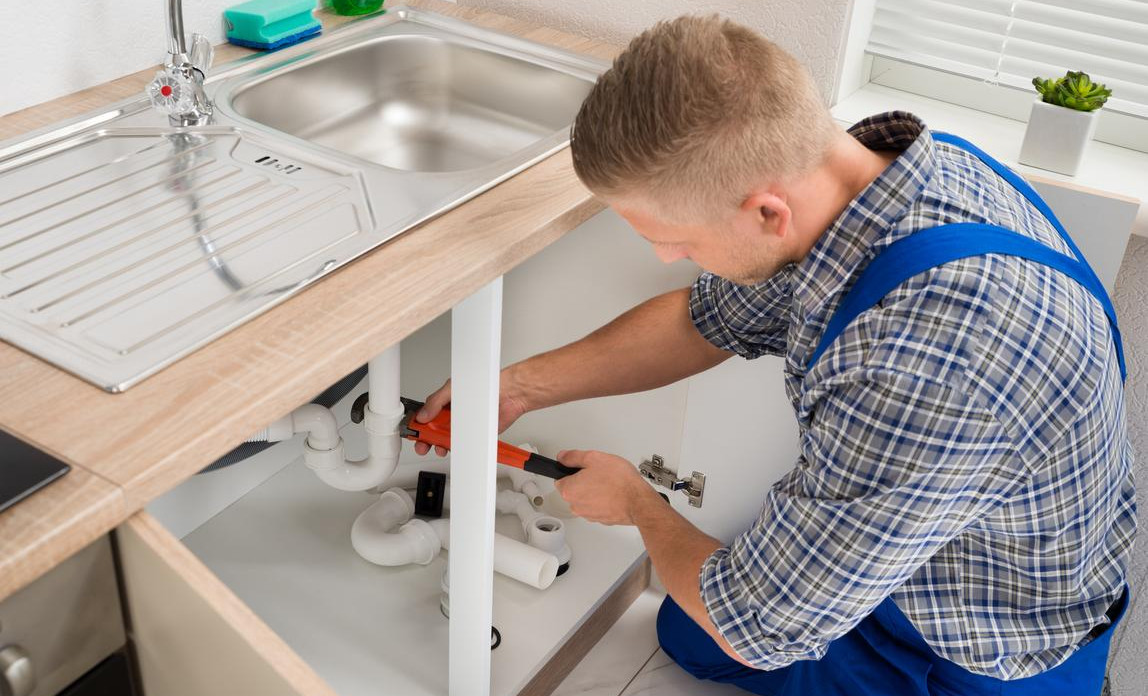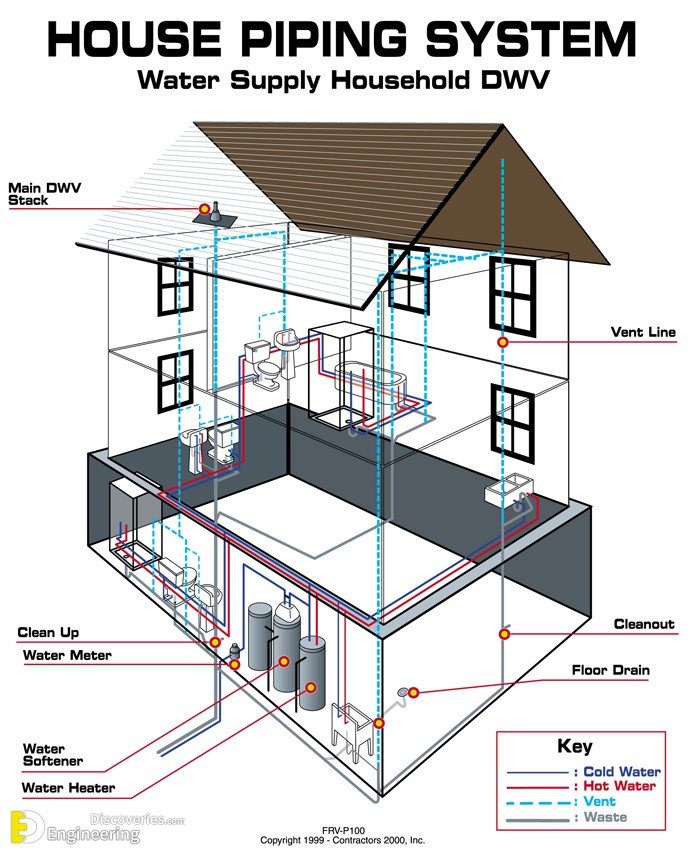The Main Elements of Your House's Plumbing System
The Main Elements of Your House's Plumbing System
Blog Article
The author is making a number of great points regarding The Inner Workings of Your Home's Plumbing in general in the content followed below.

Recognizing just how your home's pipes system functions is important for every home owner. From supplying tidy water for drinking, cooking, and bathing to safely removing wastewater, a properly maintained plumbing system is crucial for your family's health and wellness and convenience. In this thorough overview, we'll discover the detailed network that composes your home's pipes and deal pointers on upkeep, upgrades, and handling usual problems.
Intro
Your home's plumbing system is greater than just a network of pipelines; it's an intricate system that guarantees you have access to clean water and effective wastewater elimination. Recognizing its parts and how they work together can help you avoid expensive fixings and guarantee whatever runs smoothly.
Standard Components of a Plumbing System
Pipelines and Tubes
At the heart of your pipes system are the pipes and tubing that carry water throughout your home. These can be made of various materials such as copper, PVC, or PEX, each with its advantages in terms of sturdiness and cost-effectiveness.
Components: Sinks, Toilets, Showers, and so on.
Components like sinks, commodes, showers, and bath tubs are where water is made use of in your house. Comprehending exactly how these fixtures link to the plumbing system assists in identifying problems and planning upgrades.
Valves and Shut-off Points
Shutoffs control the flow of water in your pipes system. Shut-off valves are important throughout emergencies or when you need to make fixings, enabling you to isolate parts of the system without interfering with water circulation to the entire house.
Water System
Main Water Line
The major water line links your home to the municipal water or a personal well. It's where water enters your home and is distributed to numerous fixtures.
Water Meter and Pressure Regulatory Authority
The water meter steps your water use, while a stress regulator makes certain that water streams at a secure stress throughout your home's plumbing system, avoiding damage to pipes and fixtures.
Cold Water vs. Warm water Lines
Recognizing the difference in between cold water lines, which provide water straight from the main, and warm water lines, which carry warmed water from the water heater, aids in troubleshooting and preparing for upgrades.
Water drainage System
Drain Pipes Piping and Traps
Drain pipes lug wastewater away from sinks, showers, and commodes to the drain or septic system. Traps protect against drain gases from entering your home and additionally trap particles that could cause obstructions.
Ventilation Pipelines
Ventilation pipelines permit air right into the water drainage system, protecting against suction that can slow drainage and cause catches to empty. Appropriate air flow is important for keeping the honesty of your plumbing system.
Value of Proper Drainage
Making sure correct drainage stops back-ups and water damages. Frequently cleaning up drains pipes and maintaining traps can protect against costly repair work and prolong the life of your pipes system.
Water Heating System
Kinds Of Hot Water Heater
Water heaters can be tankless or typical tank-style. Tankless heaters heat water on demand, while storage tanks save warmed water for immediate use.
Exactly How Water Heaters Attach to the Pipes System
Understanding just how hot water heater connect to both the cold water supply and warm water circulation lines helps in identifying problems like not enough warm water or leaks.
Maintenance Tips for Water Heaters
Frequently purging your hot water heater to get rid of debris, checking the temperature level setups, and evaluating for leakages can expand its life-span and enhance power effectiveness.
Typical Plumbing Issues
Leaks and Their Causes
Leaks can occur because of aging pipelines, loosened installations, or high water stress. Resolving leakages immediately protects against water damages and mold development.
Clogs and Blockages
Obstructions in drains pipes and commodes are frequently caused by purging non-flushable items or an accumulation of grease and hair. Utilizing drainpipe displays and being mindful of what goes down your drains pipes can stop obstructions.
Indicators of Pipes Troubles to Expect
Low tide stress, slow-moving drains pipes, foul odors, or uncommonly high water expenses are indications of potential plumbing problems that need to be attended to immediately.
Pipes Upkeep Tips
Normal Examinations and Checks
Set up yearly plumbing inspections to capture problems early. Try to find indications of leakages, rust, or mineral accumulation in taps and showerheads.
Do It Yourself Upkeep Tasks
Simple jobs like cleansing faucet aerators, checking for commode leakages utilizing dye tablets, or shielding exposed pipes in cool environments can avoid major plumbing concerns.
When to Call a Specialist Plumbing Technician
Know when a plumbing issue calls for expert competence. Attempting complex fixings without proper knowledge can bring about more damage and higher fixing prices.
Updating Your Pipes System
Reasons for Updating
Upgrading to water-efficient fixtures or changing old pipes can boost water high quality, reduce water expenses, and raise the value of your home.
Modern Plumbing Technologies and Their Advantages
Check out innovations like clever leak detectors, water-saving toilets, and energy-efficient hot water heater that can save cash and reduce ecological impact.
Price Considerations and ROI
Compute the in advance prices versus long-lasting cost savings when considering pipes upgrades. Lots of upgrades pay for themselves with reduced energy bills and fewer fixings.
Environmental Influence and Conservation
Water-Saving Fixtures and Devices
Setting up low-flow taps, showerheads, and commodes can significantly minimize water usage without giving up efficiency.
Tips for Reducing Water Usage
Straightforward practices like repairing leakages quickly, taking much shorter showers, and running full lots of laundry and recipes can conserve water and reduced your utility expenses.
Eco-Friendly Pipes Options
Consider lasting pipes products like bamboo for flooring, which is durable and environment-friendly, or recycled glass for kitchen counters.
Emergency situation Preparedness
Actions to Take During a Pipes Emergency
Know where your shut-off shutoffs lie and exactly how to switch off the water supply in case of a ruptured pipe or major leakage.
Value of Having Emergency Situation Calls Handy
Keep contact information for local plumbing technicians or emergency services conveniently available for fast feedback throughout a pipes crisis.
DIY Emergency Fixes (When Applicable).
Short-term repairs like making use of air duct tape to spot a dripping pipeline or placing a container under a trickling faucet can reduce damages until a professional plumbing shows up.
Conclusion.
Comprehending the makeup of your home's plumbing system equips you to preserve it successfully, conserving money and time on repair work. By complying with regular maintenance routines and staying informed about modern pipes modern technologies, you can guarantee your pipes system operates effectively for many years to come.
HOW YOUR PLUMBING SYSTEM WORKS
Which Pipes Do What?
Blue lines = fresh water supply entering the building
Red lines = hot water supply entering the building
Grey lines = pipes carrying waste away from the building and venting pipes carrying gases away from the building (through the roof)
YOUR MAIN PLUMBING SYSTEMS
There are two main plumbing systems that support your home s basic plumbing needs one that brings clean water into your home, and one that sends dirty water away from your home. Connected to the toilet, bath, shower, and other faucets in your home, these two systems keep your water flowing in the right directions.
ACCESSING FRESH WATER
Fresh and clean water is brought into your home through the main water supply line . Filtered through one pipe, this water is pressured to flow into the various fixtures in your home at any given time.
This water can be sourced from a well located on your property, a pond or river (mostly cottages), or, as in most cases, from the city s municipal water treatment centre. However, it is important to note that water that is untreated, such as the water siphoned from ponds or rivers, may not be safe to drink. Personal water supplies always need to be treated for hardness and contaminants before consumed.
MUNICIPAL WATER SUPPLIES
Improve taste and odour
Remove sediment
Eliminate hardness
Reduce chlorine
COLD WATER SUPPLY VS. HOT WATER SUPPLY
Cold water flows into your home or building through the service line, which then distributes hot or cold water to your fixtures. This line is most commonly run through a central column that runs floor to floor. Hot water runs in short and straight pipes as the longer the pipeline, the more heat that will be lost in the transfer. Having shorter pipes also allows residents to access hot water more quickly.
WASTE WATER SYSTEM
Your wastewater system is divided into two parts pipes that send wastewater away from your home and venting pipes that send sewer gas away from your home. Sewage water travels through pipes that flush the water and waste towards local sewers that are operated and managed by your city or town. Most sewer systems rely on gravity to move the wastewater to where it needs to go.
The further away from your toilet or sink, the larger wastewater pipes become. This allows for waste to be disposed of from various parts of your home or business at once without pipe blockages. The angle and flow of these pipes are also essential for keeping your waste pipes clear of build up.
https://harrisplumbing.ca/how-your-home-plumbing-system-works/

HOW YOUR PLUMBING SYSTEM WORKS
Which Pipes Do What?
YOUR MAIN PLUMBING SYSTEMS
There are two main plumbing systems that support your home s basic plumbing needs one that brings clean water into your home, and one that sends dirty water away from your home. Connected to the toilet, bath, shower, and other faucets in your home, these two systems keep your water flowing in the right directions.
ACCESSING FRESH WATER
Fresh and clean water is brought into your home through the main water supply line . Filtered through one pipe, this water is pressured to flow into the various fixtures in your home at any given time.
This water can be sourced from a well located on your property, a pond or river (mostly cottages), or, as in most cases, from the city s municipal water treatment centre. However, it is important to note that water that is untreated, such as the water siphoned from ponds or rivers, may not be safe to drink. Personal water supplies always need to be treated for hardness and contaminants before consumed.
MUNICIPAL WATER SUPPLIES
COLD WATER SUPPLY VS. HOT WATER SUPPLY
Cold water flows into your home or building through the service line, which then distributes hot or cold water to your fixtures. This line is most commonly run through a central column that runs floor to floor. Hot water runs in short and straight pipes as the longer the pipeline, the more heat that will be lost in the transfer. Having shorter pipes also allows residents to access hot water more quickly.
WASTE WATER SYSTEM
Your wastewater system is divided into two parts pipes that send wastewater away from your home and venting pipes that send sewer gas away from your home. Sewage water travels through pipes that flush the water and waste towards local sewers that are operated and managed by your city or town. Most sewer systems rely on gravity to move the wastewater to where it needs to go.
The further away from your toilet or sink, the larger wastewater pipes become. This allows for waste to be disposed of from various parts of your home or business at once without pipe blockages. The angle and flow of these pipes are also essential for keeping your waste pipes clear of build up.
https://harrisplumbing.ca/how-your-home-plumbing-system-works/
We were made aware of that report on Plumbing Installation 101: All You Need to Know from an acquaintance on a different web property. Remember to take the time to distribute this post if you enjoyed reading it. Thank-you for going through it.
Click Here Report this page